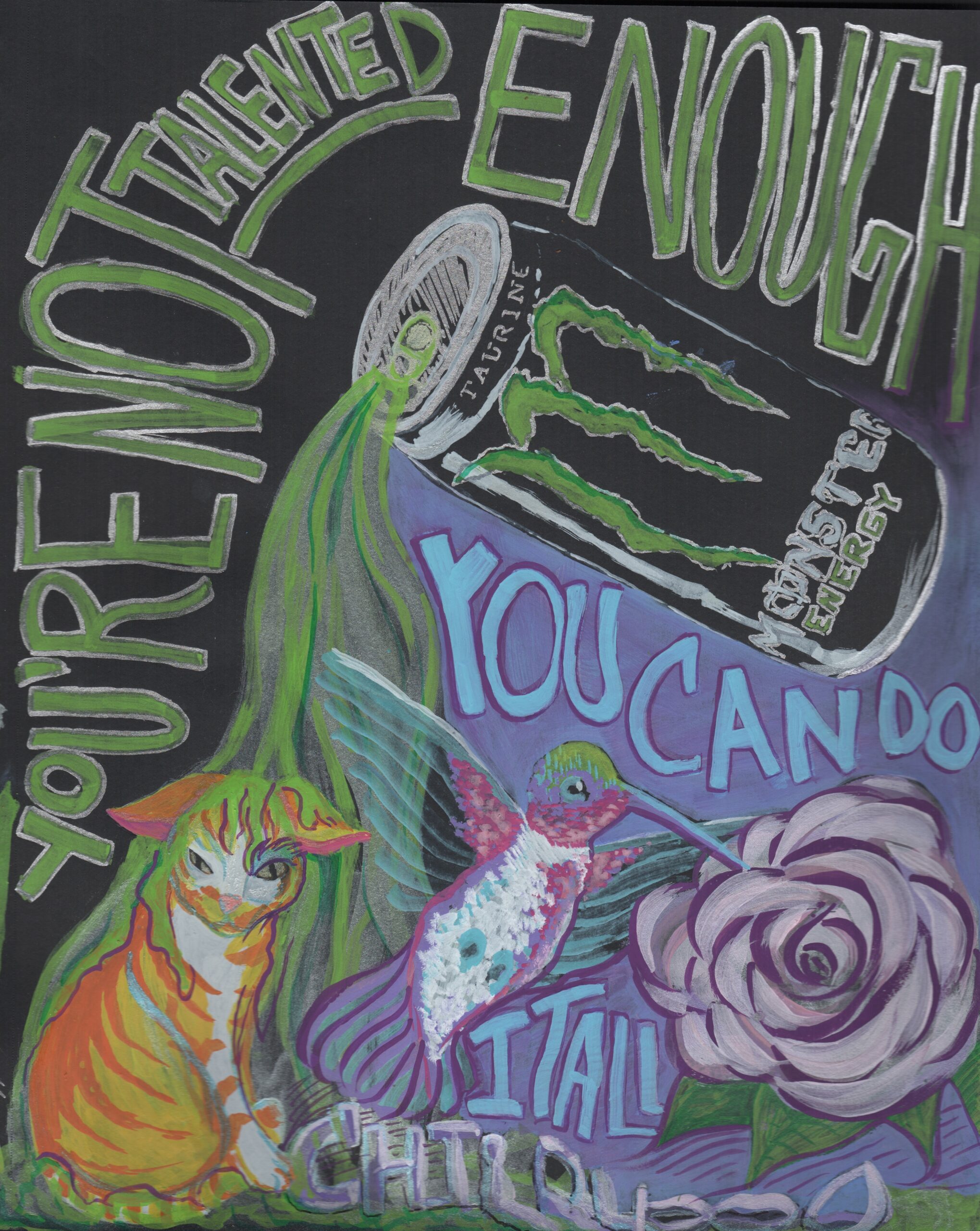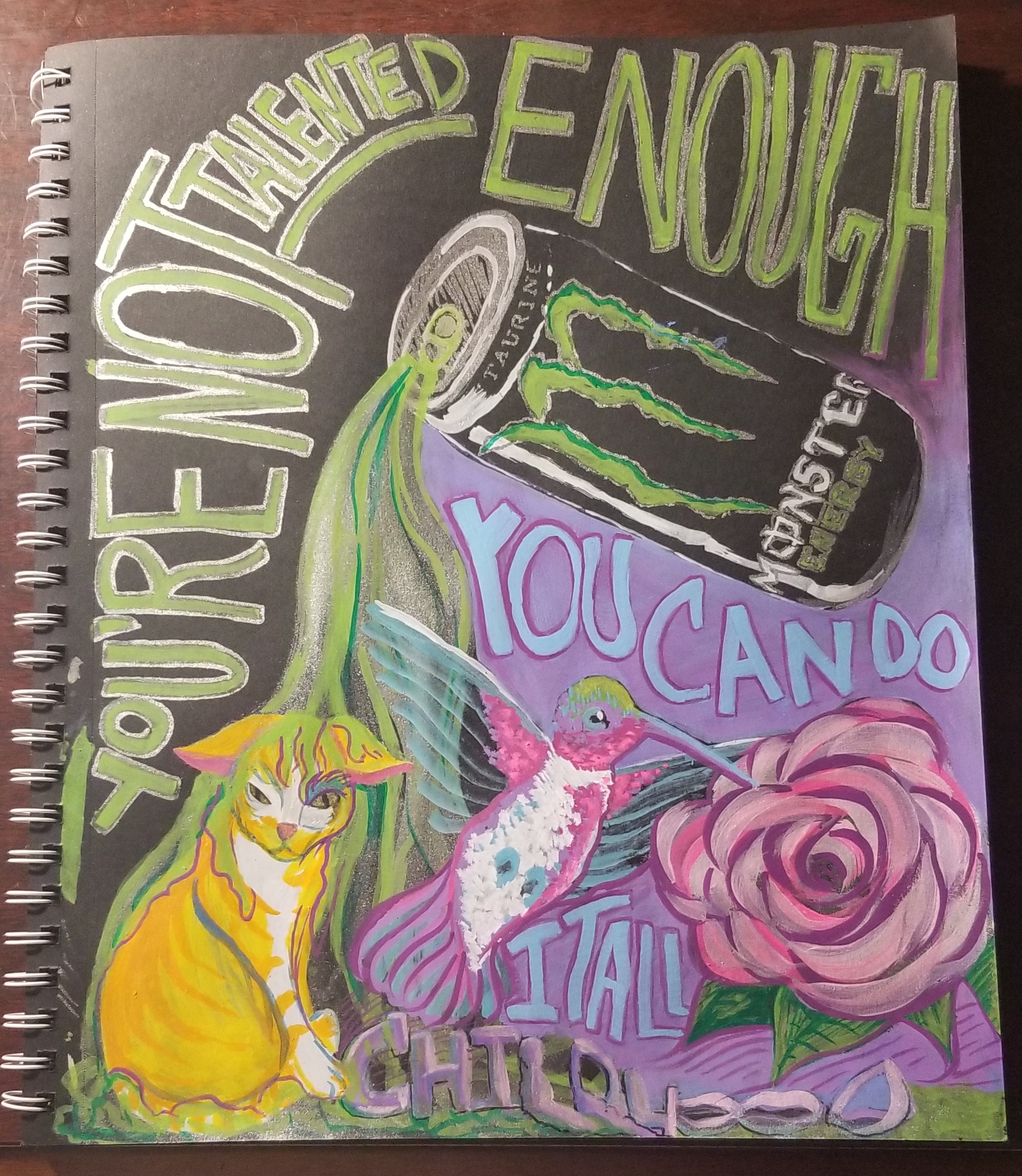
Scan of My Personal Art Education Illustration. The scanning process removed a lot of the fun from the metallic paints. I’ve included another picture of this image at the bottom to try and capture those nuances.
My Personal History of Art Education
My grandmother was an artist, although she wouldn’t have described herself as such. My mother was a disabled single parent, who was often sick or hurt. So I spent a lot of time with my grandmother. In those long wonderful summers we spent together she showed me her passion for watercolor. The very first paint I ever used, and my beginning to what would be a lifelong journey into the arts.
We disagreed on aesthetics and subject matter. She preferred to paint flowers and birds, I preferred Lisa Frank’s rainbow-colored cats. Hummingbirds were her favorite, and we studied birds extensively. John James Audubon was a big inspiration for her. We would tour the grounds he lived on and spend hours drawing and sketching out there. We walked through the woods near her home and poured plaster into animal prints. She had me study books about local wildlife, match the prints to their animal, draw the animal and then display the plaster footprint with its matching drawing. Through her, I learned that there is value in allowing the child’s curiosity to drive some of the education.
I was fortunate after becoming school age to have teachers who continued to encourage my drawing. I was in Montessori for pre-k and kindergarten. To this day I accredit that program with helping me to develop some of the artistic processes I use. Namely, the method of experience then quantify correlates directly with how I teach my students materials. It was a hands-on program, we would learn through all 5 of our senses. My Montessori teacher in pre – k and kindergarten became my mentor teacher when I was in my first years as an educator. She has continued to teach and encourage me as both a friend, a mother figure and a mentor teacher. Most importantly she taught me that no matter what, our job is for the children first.
In 5th grade, I wanted to be tested for the more advanced art class. So I asked my art teacher if she could tell me what I needed to do in order to test. She told me I wasn’t talented enough to be in that class. It was devastating and shook my self-confidence. This single incident has had the most impact on how I developed as an art teacher than any other experience in my life. I think about it daily when I interact with my students. It reminds me that their self-confidence can be fragile and that what they need from us is encouragement and faith in them. I strive to never be overly critical of them. Instead, we work together on what we both feel needs improvement.
Another teacher disagree with her and put my name in for testing. The following year I was in the more advanced art classes. It was there that I was introduced to a woman named Marcia Eisworth. I studied art under her for the next 5 years. It was her teaching and encouragement that ultimately led me to scholarships that paid for my college undergrad. She had a remarkable way of making you feel safe like you couldn’t fail even if you did. She taught me the other side of art education. I wasn’t just learning the technical drawing exercises, I was learning how to represent concepts from her.
College was another area in which my self-confidence was shaken and my skills were questioned. It was an important transition from childhood to adulthood in more than the typical ways. I had worked throughout high school to help pay the bills at my home. I had apprenticed to a face painter and spent my weekends painting at festivals around the state. This type of training altered the way I painted, even in other mediums. I painted in layers as if you would organize an image if you were screen printing it. For some professors this was unacceptable.
I came to realize that my professors were lacking as educators. They did not meet students at their needs or work with them based on the resources they had. In that way, it was my first experience with the intersection of classicism and education. I had always attended public schools and grew up poor, but this was the first time I truly understood how your financial and class status could affect the quality of teaching you receive.
In the kitchen jobs I worked as I went through undergrad I was taught to recycle materials as often as possible. We would buy a fish and use every part of it. We would create 5 or 6 different entrees from it. This method of conservationism didn’t sit well with professors, who would take off points if I didn’t buy the physical book but only had a copy of it digitally. I found old picture frames, canvas stretchers, and things made from canvas fabric at thrift stores and in dumpsters. This was what I used to build my canvasses. My professor did not appreciate my resourcefulness and instead took off points because the materials had not been purchased. I later came to find that my ability to create from recycled materials, while not appreciated in my undergrad, was extremely useful in a public school classroom.
As I began teaching and looking back into my undergrad notes and sketchbooks, I started to notice that even though my focus then was on illustration, the majority of the notes I took were analyzing teaching styles and techniques I saw in my professors. I think I always knew I needed to be in art education, even if I didn’t consciously know it. Not all of of my professors fell into the category described above. Some had a special talent for engaging students and working with them, inviting them to work collaboratively on their own education. It is those practices that I think about often when interacting with my own students.
